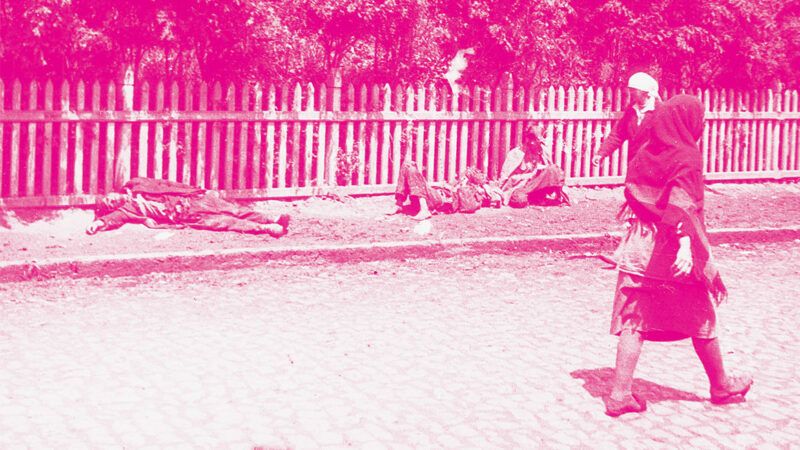Ukraine Still Hungers for Independence
For two years in the 1930s, the people of Ukraine were forced to starve in service of a political idea.

Reason's December special issue marks the 30th anniversary of the collapse of the Soviet Union. This story is part of our exploration of the global legacy of that evil empire, and our effort to be certain that the dire consequences of communism are not forgotten.
For two years in the 1930s, the people of Ukraine were forced to starve in service of a political idea. Some 5 million people died preventable deaths, victims of poisonous ideology, political vanity, and state power wielded in an attempt to destroy a national identity.
Almost 90 years later, a form of that struggle continues. To understand post-Soviet Ukraine and its ongoing tensions with Russia, you have to understand the Holodomor, the program of mass starvation forced on Ukrainians by the Soviet regime.
In the late 1920s, Soviet leader Josef Stalin sent Communist Party officials and activists out into the countryside with orders to convert private, family-owned farms into collective enterprises.
Ukrainian farmers resisted, and party leaders resorted to torture, threats, and graphic public shaming. In one Ukrainian province, according to Anne Applebaum's Red Famine (Doubleday), a gang of Communist apparatchiks marched farmers into a room one by one and demanded they submit. Those who refused were shown a revolver. If they still did not comply, they were marched into jail, with the words malicious hoarder of state grain inscribed on their backs.
Stalin's radical economic program was rooted in the idea that virtually all food supplies, land, and farming equipment were the property of the government. Collectivization was a state-sponsored program of mass theft perpetrated under the premise that Ukraine wasn't even a real country.
Without private property, personal profit, or local pride there were few incentives to work. The new state-run farms were far less productive than expected, leading to -shortages. At the same time, Stalin increased grain procurement requirements from Soviet localities—Ukraine in particular—so that most of what was produced was seized by the state. By the spring of 1932, Ukraine had begun to starve.
Local leaders wrote delicate notes to Stalin about the situation. Many pleaded for "food aid," essentially begging Russia to return a small portion of the grain the Communists had stolen from the farmers to begin with.
The famine forced on Ukraine was bound up with Stalin's effort to eliminate, often by deportation, imprisonment, or murder, the kulaks—somewhat wealthier citizens the Soviets viewed as ideological enemies. Eventually, kulak became an all-purpose term for anyone viewed as politically inconvenient, including artists, musicians, intellectuals, and writers.
The point was not merely to enact a Marxist transformation of the economy. It was to eradicate the very idea of Ukraine as a distinct political and cultural entity, a violent effort to stamp out the idea of Ukraine as an independent nation.
In the decades after the famine, the cultural memory of starvation was kept alive via whispers. The Ukrainian intellectuals and journalists who might have written their own histories had either been eliminated or were muzzled; the Soviet state would not acknowledge what it had done. Communist sympathizers in the West questioned whether it even happened.
By the mid-1980s, however, the U.S. Congress released a bipartisan report affirming the horror. Many Ukrainians, it said, "starved to death in a man-made famine in 1932–33, caused by the seizure of the 1932 crop by the Soviet authorities." In the early 1990s, after the fall of the Soviet Union, Ukraine declared independence, held democratic elections, and formally recognized the reality of the Holodomor.
Yet that period of tragedy and terror still hangs over the country's identity, and its central conflict with Russia has repeated and recurred in new forms.
In recent years, Russia has returned to denialism, allowing that some food shortages may have happened but blaming bad weather and foreign influence for the deaths. And under Vladimir Putin, Russia has waged a campaign of violence and political intimidation against Ukraine, annexing the Crimean peninsula in 2014 and waging an ongoing war in the region ever since—all while continuing to argue that the country was merely a Russian client, and thus violence and repression were justified as efforts to reclaim people and territory who were rightfully Russian to begin with.
In the summer of 2021, Putin published a lengthy, agitprop-ridden history of the region arguing that Russians and Ukrainians were really one people, not two. Modern Ukraine is entirely the product of the Soviet era, Putin wrote. For Ukraine, "true sovereignty" could only be found "in partnership with Russia." It was all part of Russia's ongoing effort to squelch the Ukrainian identity by subsuming it into the Russian state—the Holodomor's long and terrible tail. The starvation is nearly a century past, but the hunger for Ukrainian independence continues.



Show Comments (38)